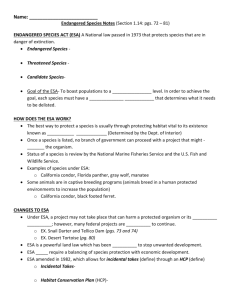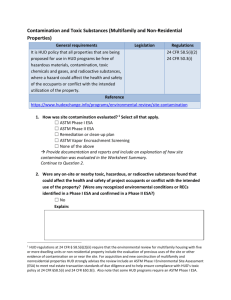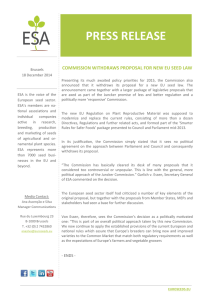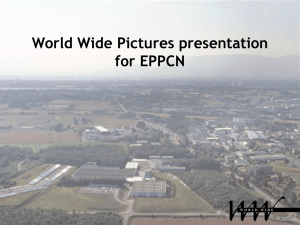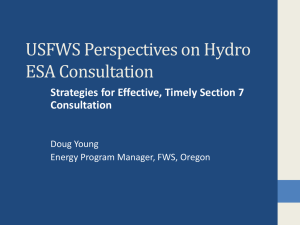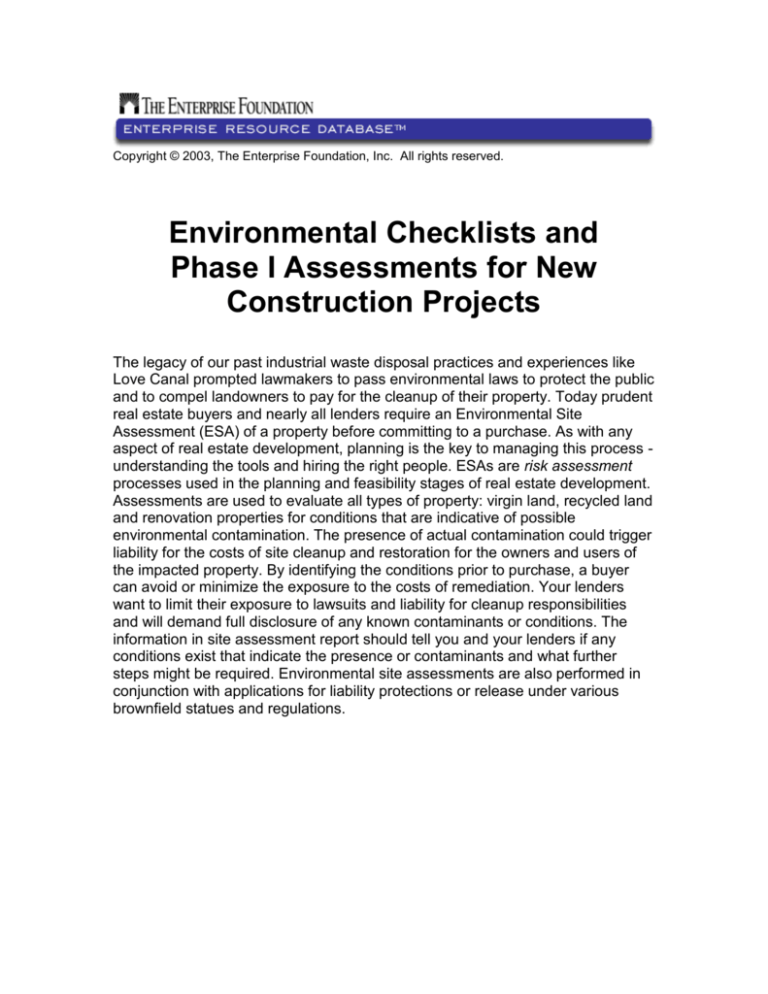
Copyright © 2003, The Enterprise Foundation, Inc. All rights reserved.
Environmental Checklists and
Phase I Assessments for New
Construction Projects
The legacy of our past industrial waste disposal practices and experiences like
Love Canal prompted lawmakers to pass environmental laws to protect the public
and to compel landowners to pay for the cleanup of their property. Today prudent
real estate buyers and nearly all lenders require an Environmental Site
Assessment (ESA) of a property before committing to a purchase. As with any
aspect of real estate development, planning is the key to managing this process understanding the tools and hiring the right people. ESAs are risk assessment
processes used in the planning and feasibility stages of real estate development.
Assessments are used to evaluate all types of property: virgin land, recycled land
and renovation properties for conditions that are indicative of possible
environmental contamination. The presence of actual contamination could trigger
liability for the costs of site cleanup and restoration for the owners and users of
the impacted property. By identifying the conditions prior to purchase, a buyer
can avoid or minimize the exposure to the costs of remediation. Your lenders
want to limit their exposure to lawsuits and liability for cleanup responsibilities
and will demand full disclosure of any known contaminants or conditions. The
information in site assessment report should tell you and your lenders if any
conditions exist that indicate the presence or contaminants and what further
steps might be required. Environmental site assessments are also performed in
conjunction with applications for liability protections or release under various
brownfield statues and regulations.
An environmental assessment
should be performed prior to the
purchase of land for
development. Typically a
Transaction Screen or Phase I
Environmental Site assessment
should be conducted before title
is transferred. Although a
Transaction Screen may be
performed by a person with
knowledge of land and real
estate, the Phase I
Even farmland may have potential
Environmental Site Assessment
environmental risks. Sink holes are
requires the services of an
indicative of possible fertilizer dumps sites
environmental professional.
or other geologic conditions that may
Although no standard definition
prevent building on the site.
or credential exists for an
environmental professional, in
general the standard of practice indicates a combination of education and
experience that is appropriate for the type of work to be performed by the person
should be expected. Professional certification and registrations are offered
through a variety of professional organizations including the National Registry of
Environmental Professionals (NREP) , which offers a listing of certified and
registered environmental professionals on its website. www.nrep.org/profs.htm
The Transaction Screen may
be used to provide guidance
as to whether a Phase I is
called for but very often
lenders require the Phase I as
a minimum acceptable level of
investigation. The screening
process is a straightforward
evaluation of the property and
can be performed by a person
with a working knowledge of
A Transaction Screen Process was enough
real estate or facility
to identify this wetland before an offer was
maintenance. Screenings are
made to buy the site for new housing
usually most appropriate for
project.
properties where no
development and no disposal
of materials has occurred, or
properties that have been
limited to residential uses. Some lenders have an in-house screening process but
the ASTM Transaction Screening Guide is the most commonly used format
(ASTM Standard Guide 1528) A general overview of the type of information
collected in a screening process is provided below:
Topography
Question
Yes
No
N/A
Are there steep slopes on the site?
Is there a grade differential on the site that will require
significant earthwork?
Are there grade or visibility limitations to access and
egress from the site?
Has the site been filled in the past?
Is the fill material adequate for the construction of the
proposed use?
Is there any knowledge that the fill could contain
hazardous materials or petroleum waste products?
Adjacent Properties
Question
Yes
No
N/A
Yes
No
N/A
Is the property in an area currently or historically used for
industrial or commercial activities?
Is the property zoned for industrial or commercial uses?
Are adjacent properties used for industrial or commercial
activities?
If there are existing or previous commercial or industrial
uses, was there any indication hazardous materials may
have been used, generated, stored or disposed of?
Drainage
Question
Are there wetlands on the property?
Are there streams, ponds or other surface water on the
property ? (Where is the nearest stream? Where are the
flood plain limits?)
Does the site drain into a municipal collection system?
Is there capacity in the downstream system for the
increase in runoff?
Will storm water detention/retention be required on site?
Is there adequate space?
Do adjacent properties drain on to the site?
Are there reasons to suspect the quality of run off from
adjacent parcels?
Are there drainage easements or permanent water
courses on the site?
The oil tank on this new construction site
could be in violation of Clean Water Act.
Why ? A high quality trout stream flows
through the site.
Utilities
Question
Are there utility easements on the property?
Are there transformers on the property?
Are there use restrictions associated with utilities?
Is onsite sewage disposal necessary for the project?
Are the soils of a type and character conducive to onsite
sewage disposal?
Have percolation tests been completed?
Has there been a recent water quality analysis?
Is an onsite well required for water supply?
Yes
No
N/A
The Phase I Environmental Assessment Process
Several factors contribute to deciding to perform a Phase I ESA. First, if the
buyer is a professional developer or a person familiar with real estate there is
some likelihood that they would be held to a higher standard of inquiry than a
simple home buyer. Second, If a site has been used for industrial or commercial
activities it is assumed there is a greater chance that hazardous materials may
have been used or stored on the property. This increased risk would compel a
greater level of inquiry. Finally, many lenders will require a Phase I as a minimum
level of inquiry.
The Phase I Environmental Site
Assessment (ESA) process is
usually performed by a qualified
environmental professional.
Although some states have
defined the minimum
qualifications for performing an
ESA, most states have not. To
determine if your state has
minimum qualifications for
The Phase I ESA report found that this
environmental professionals
building was used as a PCB
contact your state environmental
(polychorinated-biphenals)
substation
agency. The ESA process
during the 1950’s. And although the empty
requires interdisciplinary skills
lot looks like solid earth, the Phase II soil
and is therefore it is difficult to
tests revealed 4’ of debris and garbage.
prescribe a specific set of
narrowly defined qualifications.
Perhaps the best indicator of an environmental professional’s qualification is in
the combination of specific experience and education. Experience that is specific
to the property type or issues to be assessed should weigh more heavily than
other experience. When evaluating education and training consider the academic
background of individuals but also review the commitment to continuing
education and training. The ESA is a relatively new process and one that
continues to evolve so that staying current with the latest standards and
guidelines is critical for the environmental professional.
While there are a variety of different protocols offered by various technical and
professional groups, in general, the method most commonly used is the
American Society for Testing and Materials (ASTM ) Standard Practice for
Environmental Site Assessments: Phase I Environmental Site Assessment, E1527, last revised in 1997. This guideline provides clear guidance with which to
undertake an ESA but also allows for the exercise of the judgment and discretion
of the environmental professional. It should be noted that ASTM is in the process
of developing standards to address the special considerations of large tracts of
undeveloped rural properties. The purpose of the ASTM Standard Practice is to
establish a standard that would allow property buyers and developers to meet the
requirements established by the laws and courts to minimize the risks of
environmental liability associated with buying property. Some lenders have their
own ESA protocols that must be used instead of the ASTM Standard.
In addition to the ASTM Standard Guides, lenders and mortgage insurers may
require the evaluation of other conditions. These other conditions could include
asbestos, lead-based paints, wetlands, historic preservation issues, radon,
drinking-water quality, Americans with Disabilities Act compliance among others.
The scope of the inquiry can vary from region to region, from lender to lender and
from site to site. Assessment practices can vary as well. Fannie Mae, Freddie
Mac, FHA/HUD, private banks and Community Finance Agencies have all
established the own requirements for ESAs, some of which are more stringent
than others. For example, Freddie Mac’s Environmental Survey and
Environmental Report has a specific soil sampling requirement which in effect
combines a Phase I and a limited Phase II. Other lenders require asbestos or
lead-based paint surveys as part of the Phase I. In any case, you can see it is
important to understand what the requirements of the lender are before you start
the assessment process.
The ASTM Standard also creates a framework for the client to evaluate the
proposed work product of the environmental professional in the context of the
proposed project. For example, the ASTM Standard Practice does not call for the
collection of samples, however you might decide that it would be appropriate to
samples for lead based paint or asbestos in a building you are considering for
renovation. In this case the scope of work would have to be modified to include
the collection of samples and the laboratory analysis. Using the ASTM Standard
as a guidance document, you can decide to accept the scope of work as it is
presented or modify it to meet your specific goals.
Finally, the Standard can be used to evaluate the final work product of the
environmental professional. A checklist of the key points of the ASTM Standard
may be used to measure the completeness of the report and work effort. An
example of such a quality assurance checklist is attached.
BENEFITS AND LIMITATIONS OF A PHASE I ESA
The Phase I ESA is designed in principle to be a cost effective overview of a site
which should identify indications of recognized environmental conditions. To
keep the cost of the investigation at a reasonable level, the typical Phase I ESA
involves no collection or testing of samples and is limited to information already
available through public sources, interviews or first hand observation. This
approach allows a buyer to determine if there is an indication of a problem or an
increased risk with a particular property.
By limiting the scope of the ESA the cost is minimized but the conclusions of the
environmental professional are therefore drawn from limited information. For this
reason the environmental professional may be unable to conclude that
contamination is or is not present stating instead she can conclude only that
there are indications of this condition or that circumstance which could indicate
contamination.
The ESA Report should include copies of the notes collected during interviews,
the database review summaries, maps, aerial photos and any other reasonable
documentation referenced in the report. Most importantly the report should
include recommendations for next steps to follow based on the research and
experience of the assessor. The following checklist was prepared as a tool to
help non-technical readers evaluate a Phase I Report.
Phase I Environmental Site Assessment Guidelines and Quality
Assurance Review
This Phase I Environmental Site Assessment (ESA) Guidelines Review checklist
is to be completed for the quality assurance purpose of verifying the substantive
compliance of an ESA report with the ASTM Standard Practice for Environmental
Site Assessments: Phase I Environmental Site Assessment Process, E-1527.
Except where noted otherwise, this review is based entirely on the report and
does not include an independent confirmation of information.
PROJECT NAME
REPORT PREPARED BY
ADDRESS
PHONE NUMBER
FAX NUMBER
DATE OF REPORT
DATE OF REVIEW
RECORDS REVIEW
YES NO N/D
Does the report reference ASTM E-1527?
( ) ( )( )
Was the ESA conducted by an environmental professional?
( ) ( )( )
Is a resume or statement of qualification attached?
Were proper Minimum Search Distances used in the record
search?
Federal NPL Site List (1 mile)
( ) ( )( )
( ) ( )( )
( ) ( )( )
Federal CERCLIS list (.5 mile)
( ) ( )( )
Federal RCRA TSD list (1 mile)
( ) ( )( )
Federal RCRA generators list (property
and adjoiners)
Federal ERNS list (property only)
( ) ( )( )
Equivalent state lists
( ) ( )( )
State landfill lists (.5 mile)
State Leaking Underground Storage Tank
(LUST) list(.5 mile)
State registered underground storage tank
(UST) list (property and adjoiners)
If proper minimum search distances were not used was
justification for each reduction and the new minimum distance
provided?
Did the environmental professional provide an opinion as to
the significance of any listing as a recognized environmental
condition within the minimum search distances?
( ) ( )( )
( ) ( )( )
( ) ( )( )
( ) ( )( )
( ) ( )( )
( ) ( )( )
Was a current USGS 7.5 Minute Topographic map used as the
source of the physical setting data?
( ) ( )(
Identify the sources used to determine the history of the site
and surrounding areas:
( ) ( )(
Aerial photographs
( ) ( )(
Local historic maps
( ) ( )(
)
)
)
)
Historic USGS topographic maps
( ) ( )( )
Fire Insurance Maps
( ) ( )( )
Tax Files
( ) ( )( )
Local records
( ) ( )( )
Interviews
( ) ( )( )
50 year chain of title
( ) ( )( )
SITE RECONNAISANCE
Did the environmental professional report any obstructions, or
obstacles that would prevent a thorough site reconnaissance?
Was the exterior of the property visually and physically
observed and the description included in the report?
Was an inspection of the interior of the buildings conducted
including accessible common areas and a representative
sample of occupant areas?
Was information from a prior ESA used in the report?
( ) ( )( )
( ) ( )( )
( ) ( )( )
( ) ( )( )
( ) ( )( )
Were changes between the earlier ESA and current
observations noted?
Were the uses and conditions of the site reported?
Was the owners representative present during the site visit?
( ) ( )( )
Were interviews conducted?
Did the owner provide any additional documentation regarding
the site?
Does the report include references to site conditions not
visually and physically observed by the environmental
professional?
Does the report include:
A description of the current site use and
conditions?
A description of the adjoining property
uses and conditions?
A description of the topographic and
hydrologic conditions?
A general description of the structures?
( ) ( )( )
Is the source of potable water identified?
The locations of roads and parking areas
described?
Past uses of the property discernible?
( ) ( )( )
( ) ( )( )
( ) ( )( )
( ) ( )( )
( ) ( )( )
( ) ( )( )
( ) ( )( )
( ) ( )( )
( ) ( )( )
( ) ( )( )
( ) ( )( )
Based on this review, does the ESA meet the standard guidelines?
It is important to note that the environmental professional is expected to exercise
good judgment in the completion of the ESA. In some cases the environmental
Professional may elect to modify the ESA guidelines. While these changes are to
be expected, deviations from the standard should be noted and explained to your
satisfaction.


